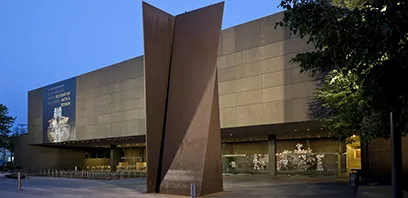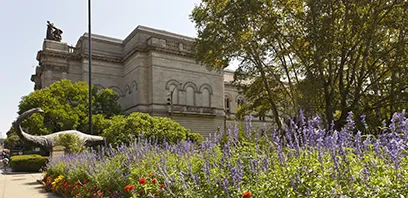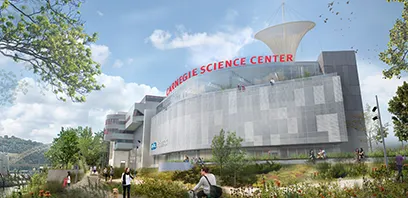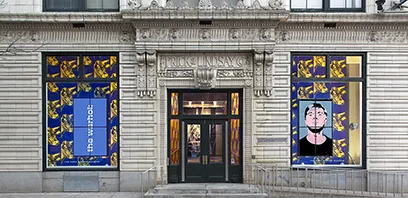Home
Museums
Back Issues
Membership
Carnegie Museum of Natural History Paleontologist
is one of 25 Fellows named for the year 2000
The MacArthur
Fellows selected each year by the John D. and Catherine T. MacArthur Foundation
have certain common traits. They tend to be advocates of some singular
perspective that challenges fundamental boundaries. They mine the
arts, history, and science and come up with creative definitions that can
possibly change the way we understand and live in the world.
Chris Beard, Associate Curator of Vertebrate
Paleontology at Carnegie Museum of Natural History, is a paleontologist
who is reshaping critical debates about the evolution of mammals, such
as the earliest “Dawn monkey,” Eosimias. His discovery in China of
the earliest primates has changed thinking about the geographic origins
of mammals, such as anthropoids and humans. If you project Beard’s
research far enough, the metaphoric Garden of Eden where familiar life
forms began might have been in China, and not in Africa or the Middle East,
as was previously thought.
Among Beard’s 25 Fellows in the year 2000
is the founder of the Audubon Society’s Living Oceans Program, Carl Safina,
who wants to dispel the notion that the oceans are a limitless source of
food and other resources as well as a garbage dump. Also there
is an architect and teacher who uses odd building materials such as old
tires, bottles, and scrapwood to build beautiful, ingenious homes in remote
parts of Alabama (Samuel Mockabee), and a photographer and scholar
(Deborah Willis) who champions the rich legacy of African-American photography.
Physicist Hideo Mabuchi at California Institute of Technology studies how
atoms behave differently in a noisy environment, using optics to see interactions
between pure quantum physics and noisy experimental environments.
Susan Sygall, working from her own wheelchair, has a mission to improve
the rights and change the lives of women with disabilities in the poorest
regions of the world.
There is a mystique to being named a MacArthur
Fellow. When an individual is named, the news strikes like lightening on
a blue June day. The person gets an unexpected phone call announcing
that he or she has been named a Fellow from Daniel J.
Sokalow, director of the program. Sokalow says the award winners’
first reactions are familiar to him: “You’re kidding me
I don’t know what
to say
I’m flabbergasted
flattered
you’ve made my life a lot easier
.”
The award is a half-million dollar grant spread over five years, with no
strings attached. You can pay off your debts, travel, take time off
from your institution to do research, seed your own program, create a scholarship,
buy equipment–and never write a report.
But you could never apply for this fellowship.
Instead you have been nominated by a changing committee of anonymous experts
who have a confidential voting system to assure candid opinions.
After selecting driven, focussed people who are trying with their life’s
work to make the world better or more understandable, the MacArthur Foundation
backs up its choice with the wisdom that these individuals themselves will
know the wisest way to use the money. The Foundation wants to guarantee
them time to think, to address their most fundamental issues, and gives
them the seed money or the venture capital to advance their own specific
intellectual, social, or artistic enterprises.
The John D. and Catherine T. MacArthur
Foundation has been selecting and supporting people of exceptional creativity,
with a record of significant accomplishment, and the potential for still
greater achievement, since the program began in 1981. Each year between
20 and 40 are named, reaching a total of 588 this year. The
Foundation itself does not use the word “genius,” since it’s a limiting
term that defines only one aspect of true life-long creativity. Still,
the press has used the term “Genius Awards” for years.
President Ellsworth Brown of Carnegie Museums
of Pittsburgh sees the MacArthur award as good for the scientist, the museum,
and the city: “I am thrilled for Chris and tremendously proud of
him and his colleagues. His research brings international attention
to Pittsburgh and confirms the work of our museum.” Likewise the
chairman of the Carnegie Museum of Natural History Board, George F.Eichley,
sees the importance of the award as solidifying the museum’s reputation
as one of the foremost research institutions in the world: “This
is scientific inquiry of the highest standard and fulfills a significant
part of the museum’s mission.” Director Sokalow of the MacArthur
Fellows program says simply, “We think of Chris as a discoverer,
bold, serious, and highly creative.”
Home
Museums
Back Issues
Membership
Copyright (c) 2000 CARNEGIE magazine
All rights reserved.
E-mail: carnegiemag@carnegiemuseums.org



